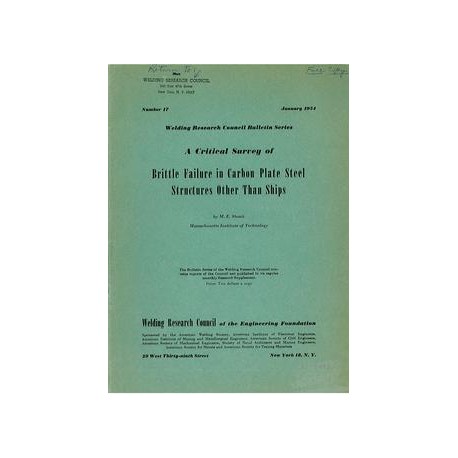Product successfully added to your shopping cart
Quantity
Total
There are 1 items in your cart. There is 1 item in your cart.
Total products $47.08
Total shipping To be determined
Total $47.08
New Reduced price!  View larger
View larger
 View larger
View larger WRC 017
M00000996
New product
WRC 017 A Critical Survey of Brittle Failure in Carbon Plate Steel Structures Other Than Ships
Bulletin / Circular by Welding Research Council, 1954
M. E. Shank
In stock
More info
Full Description
The failure of ships at sea and at dockside during World War II brought the problem of brittle fracture into sharp focus. Data from ship failures have been well correlated, and as a result, much has been learned from research stimulated thereby. No similar correlation on non-ship failure data exists, and this survey was therefore undertaken in order to supplement the study of ship failures. A total of 64 structural failures, plus failures in gas transmission lines, was studied. These failures occurred in both riveted and welded structures such as tanks bridges, pressure vessels, a smoke stack, a penstock, power shovels, as well as gas transmission lines. It is shown that the history of brittle failure extends back at least to 1879. It is concluded that:1. Brittle failure in non-ship structures is the same phenomenon as occurs in ships;2. Brittle failure occurs in many types of non-ship structures;
3. Brittle fractures can cross riveted joints;
4. There is no evidence to show that the percentage incidence of brittle failure has either decreased or increased with the advent of welding;
5. In conjunction with other factors, thermal stress may be important;
6. Residual stresses are not the prime cause of brittle failure, but such stresses may, in conjunction with other factors, initiate such failure;
7. The effect of metallurgical variables is important;
8. Cold forming promotes susceptibility to brittle failure, but its role cannot be assessed due to lack of data;
9. In such cases where data are available, Charpy impact values of plate were generally low at the failure temperature;
10. In most cases of non-ship brittle failure, the fracture originated at defects arising from fabrication. A few originated at design defects;
11. It seems evident in all cases that fracture originated at a geometric discontinuity;
12. No evidence exists for these failed structures to show the effects of various welding processes on susceptibility to brittle failure;
13. Except in the case of exceptionally poor welds, there is no tendency for fracture to follow welded seams;
14. The great majority of non-ship brittle failures apparently occur under conditions of entirely static loading;
15. Age of structure seems to have no bearing on brittle failure;
16. Most engineering codes permit the use of steel which is known to be particularly susceptible to brittle failure. At the same times, under all codes but one, the stress levels are held to quite conservative values;
17. Finally, it is demonstrated that brittle failure results from a combination of many factors.There is no readily available material which would entirely prevent its occurrence, and there is no known test which will surely predict from the behavior of small specimens the performance of a given steel in circumstances where structural brittle failure might occur. In short, careful design, selection of materials and good workmanship are of the greatest importance in the prevention of brittle failure in non-ship structures. This is also true of ships.


